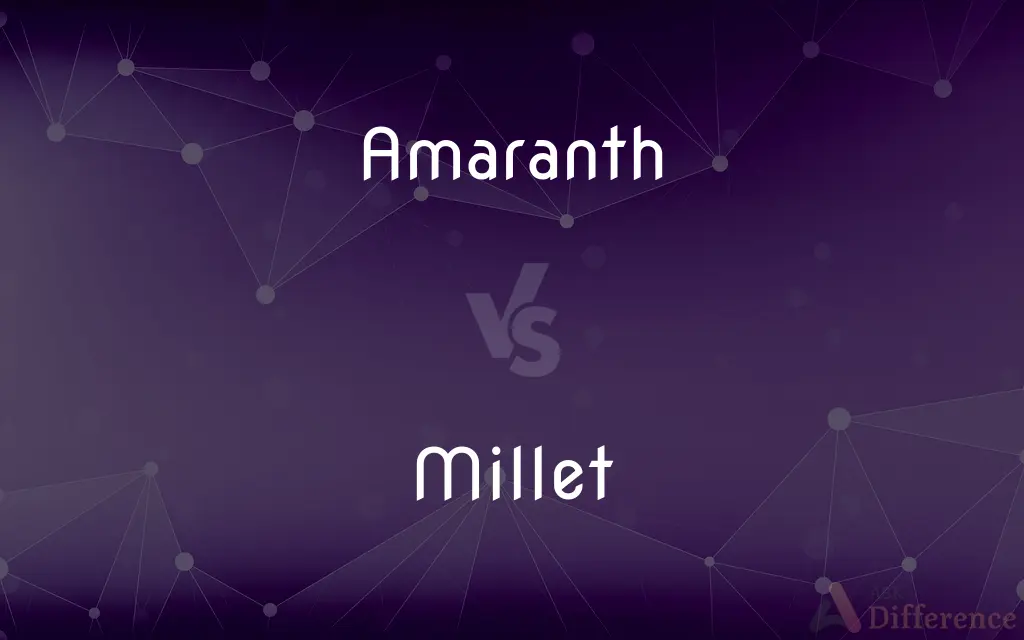Amaranth vs. Millet — What's the Difference?
By Fiza Rafique & Maham Liaqat — Updated on May 18, 2024
Amaranth is a gluten-free, nutrient-rich pseudo-grain known for its high protein and calcium content, while millet is a group of small-seeded grasses used as grains, also gluten-free, valued for its versatility and easy digestion.

Difference Between Amaranth and Millet
Table of Contents
ADVERTISEMENT
Key Differences
Amaranth is a pseudo-grain, meaning it is not a true cereal grain but has similar uses. It's renowned for its high protein content, including lysine, an amino acid often lacking in other grains. Millet, on the other hand, refers to a group of small-seeded grasses cultivated as grains. It is also gluten-free and is known for being easy to digest, making it suitable for people with digestive issues.
Both amaranth and millet are gluten-free and highly nutritious, but they differ in their botanical classifications and specific nutrient profiles. Amaranth is a pseudo-grain with higher protein content, while millet is a true cereal grain known for its ease of digestion and versatility in cooking.
Amaranth's historical significance dates back to ancient civilizations such as the Aztecs, who revered it as a staple crop. Millet has been a staple in African and Asian diets for thousands of years, valued for its adaptability to arid climates.
Comparison Chart
Classification
Pseudo-grain
True cereal grain
Nutrient Profile
High in protein, calcium, iron, magnesium
Rich in B vitamins, iron, magnesium
ADVERTISEMENT
Gluten-Free
Yes
Yes
Flavor
Slightly nutty
Mild, slightly sweet
Uses
Porridge, baked goods, salads
Porridge, flatbreads, rice substitute
Historical Significance
Ancient civilizations (Aztecs)
Staple in African and Asian diets
Digestibility
Moderate
Easy to digest
Compare with Definitions
Amaranth
Known for its slightly nutty flavor.
Adding amaranth to salads gives a crunchy texture.
Millet
Highly digestible and suitable for those with digestive issues.
Millet porridge is easy on the stomach.
Amaranth
Gluten-free and suitable for various dietary needs.
Amaranth flour is often used in gluten-free baking.
Millet
Known for its mild, slightly sweet flavor.
Millet makes a great base for salads and side dishes.
Amaranth
A pseudo-grain high in protein and essential nutrients.
Amaranth porridge is a nutritious breakfast option.
Millet
A staple in African and Asian cuisines for thousands of years.
Millet is a common ingredient in traditional African flatbreads.
Amaranth
Rich in calcium, iron, and magnesium.
Amaranth provides significant amounts of essential minerals.
Millet
Millets () are a group of highly variable small-seeded grasses, widely grown around the world as cereal crops or grains for fodder and human food. Millets are important crops in the semiarid tropics of Asia and Africa (especially in India, Mali, Nigeria, and Niger), with 97% of millet production in developing countries.
Amaranth
Amaranthus is a cosmopolitan genus of annual or short-lived perennial plants collectively known as amaranths. Some amaranth species are cultivated as leaf vegetables, pseudocereals, and ornamental plants.
Millet
A cereal grown in warm countries and regions with poor soils, bearing a large crop of small seeds which are chiefly used to make flour.
Amaranth
Any of various annual plants of the genus Amaranthus having dense green or reddish clusters of tiny flowers and including weeds, ornamentals, and species cultivated for their edible leaves and seeds. Also called pigweed.
Millet
Any of various annual grasses with small grains that are harvested for food, livestock feed, and birdseed, especially proso millet.
Amaranth
The small edible seeds of several of these species.
Millet
The grains of any of these plants.
Amaranth
An imaginary flower that never fades.
Millet
A demographic group in the Ottoman Empire, defined in terms of religious affiliation and enjoying a degree of legal autonomy.
Amaranth
A deep reddish purple to dark or grayish, purplish red.
Millet
Any of a group of various types of grass or its grains used as food, widely cultivated in the developing world.
Amaranth
A dark red to purple azo dye.
Millet
(specifically) common millet, in particular Panicum miliaceum.
Amaranth
An imaginary flower that does not wither.
Millet
(historical) A semi-autonomous confessional community under the Ottoman Empire, especially a non-Muslim one.
Amaranth
Any of various herbs of the genus Amaranthus.
Millet
The name of several cereal and forage grasses which bear an abundance of small roundish grains. The common millets of Germany and Southern Europe are Panicum miliaceum, and Setaria Italica.
Amaranth
The characteristic purplish-red colour of the flowers or leaves of these plants.
Millet
Any of various small-grained annual cereal and forage grasses of the genera Panicum, Echinochloa, Setaria, Sorghum, and Eleusine
Amaranth
(chemistry) A red to purple azo dye used as a biological stain, and in some countries in cosmetics and as a food colouring.
Millet
French painter of rural scenes (1814-1875)
Amaranth
(cooking) The seed of these plants, used as a cereal.
Millet
Small seed of any of various annual cereal grasses especially Setaria italica
Amaranth
An imaginary flower supposed never to fade.
Millet
A group of small-seeded grasses used as grains.
Millet can be cooked like rice or quinoa.
Amaranth
A genus of ornamental annual plants (Amaranthus) of many species, with green, purplish, or crimson flowers.
Millet
Rich in B vitamins, iron, magnesium, and phosphorus.
Millet provides a good source of essential nutrients.
Amaranth
A color inclining to purple.
Amaranth
Seed of amaranth plants used as a native cereal in Central and South America
Amaranth
Any of various plants of the genus Amaranthus having dense plumes of green or red flowers; often cultivated for food
Amaranth
Cultivated since ancient times, notably by the Aztecs.
Amaranth was a staple food for the Aztecs.
Common Curiosities
Which has more protein, amaranth or millet?
Amaranth has higher protein content compared to millet.
What is millet?
Millet is a group of small-seeded grasses used as grains, known for their ease of digestion and nutritional benefits.
Is millet gluten-free?
Yes, millet is gluten-free.
What is amaranth?
Amaranth is a nutrient-rich pseudo-grain known for its high protein content and essential minerals.
What does millet taste like?
Millet has a mild, slightly sweet flavor.
Is amaranth gluten-free?
Yes, amaranth is gluten-free.
Where has millet been historically significant?
Millet has been a staple in African and Asian diets for thousands of years.
Is millet easy to digest?
Yes, millet is known for being easy to digest.
How is amaranth used in cooking?
Amaranth can be used in porridges, salads, and baked goods.
Is amaranth easy to digest?
Amaranth is moderately digestible.
What nutrients are abundant in amaranth?
Amaranth is rich in protein, calcium, iron, and magnesium.
What does amaranth taste like?
Amaranth has a slightly nutty flavor.
How is millet used in cooking?
Millet can be used in porridges, as a rice substitute, and in flatbreads.
What nutrients are abundant in millet?
Millet is rich in B vitamins, iron, magnesium, and phosphorus.
Where has amaranth been historically significant?
Amaranth was significant in ancient civilizations, notably the Aztecs.
Share Your Discovery

Previous Comparison
Tinder vs. Kindle
Next Comparison
Lunatic vs. NutcaseAuthor Spotlight
Written by
Fiza RafiqueFiza Rafique is a skilled content writer at AskDifference.com, where she meticulously refines and enhances written pieces. Drawing from her vast editorial expertise, Fiza ensures clarity, accuracy, and precision in every article. Passionate about language, she continually seeks to elevate the quality of content for readers worldwide.
Co-written by
Maham Liaqat















































